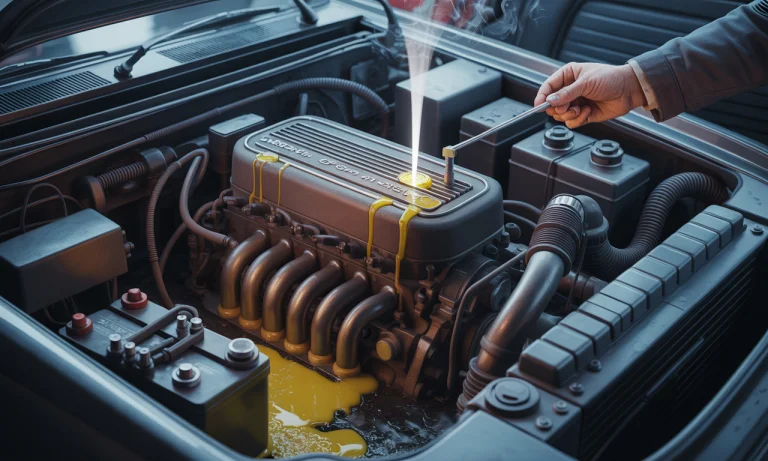There are moments on the road when a quiet hum beneath the hood gives way to an unexpected rattle, a flash on the dashboard, or a trail of dark smoke in your rearview mirror. In 2025, with vehicles more advanced than ever—carrying sophisticated sensors and self-diagnosis technology—drivers still need to recognize the patterns behind those sudden warnings. Even as electric and hybrid models become mainstream, and high-tech interface gadgets inform us at every turn (learn more from this guide on automotive innovation), the fundamentals of engine care remain. Overlooking the early signals of engine trouble—those red flags that pop up in daily driving—could spell disaster, both financially and for one’s safety. Understanding these clues means your journey continues uninterrupted, and your car’s value and reliability stay strong in an era where every mile can make a difference. Whether you’re behind the wheel of a classic gas model or a state-of-the-art EV, being attentive to symptoms like the notorious Check Engine Light, unexplained vibrations, or dwindling fuel efficiency can save you from ruined plans and towering repair bills.
Recognizing Engine Warning Signs: The Story Behind the Dashboard
Picture this: Jamie, a daily commuter, noticed their Check Engine Light flickering on during an early morning drive to work. The roads were damp with spring rain, and the traffic was crawling. Jamie, like many others, hesitated—should they pull over or keep going? The Check Engine Light flashes for countless reasons: a failing oxygen sensor, a loose gas cap, or something as costly as a failing catalytic converter. Modern vehicles boast intricate onboard diagnostics, yet the heart of these warnings remains: unresolved engine distress. Ignoring even a flicker can turn a routine commute into a tale of being stranded roadside, caught between the rush of the morning and the uncertainty of waiting for a tow. When those dials and symbols light up, it’s your car’s way of urging for help before a small issue spirals into catastrophic failure.
The Impact of Neglecting Warning Lights on Engine Longevity
Consider those who wait until multiple lights flash before seeking help. One ignored warning can trigger a chain reaction—overheated components, deteriorated seals, or compromised safety systems. A well-maintained vehicle not only ensures reliability for years, it also retains its value, especially when you’re preparing for a sale. Discover more on boosting resale value at Left Lane News.
Strange Noises, Vibrations, and Rough Idling: Listening to Your Engine’s Language
Few things unsettle a driver like Strange Noises emerging suddenly from under the hood. When Emma’s sedan began emitting a persistent knocking—paired with excessive engine vibrations—she initially dismissed it as minor. Yet these symptoms, especially if accompanied by Rough Idling or Difficulty Starting, often indicate underlying oil flow problems or failing components. Knocking typically means metal parts are grating without enough lubrication; excessive engine vibrations may suggest loose mounts or internal misfires. Ignore these signs, and what begins as a faint rattle could escalate to power loss and costly repairs. Routine checks and prompt visits to your mechanic are the best defense against escalation. A smooth-running engine hums—not shakes, shudders, or knocks.
Case Study: How Routine Maintenance Prevents Engine Damage
Consider the experience of a rideshare driver who had grown accustomed to a constantly decreasing fuel efficiency meter. By addressing the sounds and vibrations promptly at their trusted workshop, they avoided a costly breakdown and extended the engine’s lifespan. For those wanting to avoid a trip to the mechanic’s for every hiccup, familiarize yourself with effective car maintenance routines that target potential issues before they surface.
Oil Leaks, Power Loss, and Excessive Exhaust Smoke: Visual Cues of Engine Trouble
A telltale puddle beneath the parked car. The subtle sheen of oil on the driveway. These are silent signals—often overlooked—in the story of vehicle health. Oil Leaks, while sometimes slow, point to gasket failures or worn seals. Left unchecked, leaks gradually starve the engine of lubrication, risking heat damage and part failure. Meanwhile, Power Loss on acceleration or inclines suggests airflow or fuel delivery issues, often related to blocked filters or troubled spark plugs.
Reading the Exhaust: What Smoke Colors Reveal
Excessive Exhaust Smoke, visible to anyone driving behind, speaks plainly about what’s happening within. White smoke hints at coolant leaks and looming overheating; black smoke often reveals a fuel system gone awry; blue smoke marks active oil burning—each color a clear call for diagnostic intervention. Ignoring such cues could mean being sidelined by a simple, solvable leak or a long-term, catastrophic engine failure.
| Smoke Color | Likely Cause | Potential Consequence |
|---|---|---|
| White | Coolant Leak | Engine Overheating |
| Black | Rich Fuel Mixture, Faulty Injectors | Decreased Fuel Efficiency |
| Blue | Oil Leak/Burning Oil | Engine Damage, Fire Risk |
To learn more about managing oil leaks and preventing major failures, explore expert tips on saving money on car repairs.
Engine Overheating and Fluid Warnings: Staying Ahead of Disaster
When the Temperature Warning Light blazes, recalling sweltering summer commutes or long-haul road trips, drivers are facing more than temporary discomfort—they’re on the brink of expensive repairs. Engine Overheating can stem from coolant leaks, malfunctioning water pumps, or stuck thermostats. If left unchecked, overheating warps engine parts, causing permanent loss of power or even total failure. Jamie, the commuter, once ignored a creeping temperature gauge while stuck in holiday traffic—six hours and a cracked radiator later, a simple coolant check would have averted the disaster. Pay heed to your vehicle’s warnings and ensure a smooth ride by preparing for trips beforehand. Some helpful steps are available in the road-trip readiness guide.
Fluid Maintenance Schedule and Quick Reference Guide
The path to avoiding breakdowns starts with regular checks. Coolant, oil, and even windshield washer fluid levels must stay within recommended limits. Disregarding a flashing fluid warning can leave you stranded or—worse—cause irreparable engine damage. A reliable fluid maintenance routine is key for peace of mind and vehicle longevity.
| Fluid Type | Check Frequency | Warning Signs | Action |
|---|---|---|---|
| Oil | Monthly | Oil Leaks, dashboard oil light | Top up, inspect for leaks |
| Coolant | Before long trips | Engine Overheating, low reservoir | Refill, check hoses |
| Transmission Fluid | As recommended | Sluggish shifting, warning light | Flush or top up |
Expand your maintenance knowledge and optimize your engine performance through detailed engine care guides.
Embracing Tomorrow: Engine Maintenance in Electric and Hybrid Vehicles
Today, more drivers are steering toward electric and hybrid vehicles, drawn by promises of sustainability and reduced maintenance. However, even these technologically advanced models require keen attention to maintenance signals. Battery system alerts, sudden Decreased Fuel Efficiency in hybrids, and electrical errors all have their own dashboard languages—as vital as Check Engine Light for traditional powertrains. The core rule holds: whether you’re test driving a new electric car (test driving electric), or relying on a hybrid during a cross-country journey, timely maintenance checks prevent costly surprises.
Comparative Maintenance Costs: Electric vs. Gasoline Engines
While electric cars eliminate oil changes and reduce vibration-related wear, they present unique warning signs—like irregular charging or excessive battery heat. For a side-by-side analysis of maintenance expenses and to understand emerging trends, visit the EV vs gasoline maintenance cost breakdown. Knowing what to expect helps drivers stay ahead in the digital age of driving—and ensures every journey remains as worry-free as that first drive off the lot.
Engine Maintenance Quick Reference Table for Drivers
| Symptom | Possible Cause | Recommended Action |
|---|---|---|
| Check Engine Light | Sensor or emission problem | Diagnostic scan, visit mechanic |
| Rough Idling | Fuel/air system issue | Inspect filters, clean or replace parts |
| Decreased Fuel Efficiency | Faulty spark plugs, poor maintenance | Tune-up, check oxygen sensor |
| Strange Noises | Lack of lubrication, worn parts | Add/replace oil, mechanical inspection |
| Difficulty Starting | Battery, starter, or fuel issues | Check battery, fuel system service |
| Excessive Exhaust Smoke | Burning oil, coolant, or rich fuel | Check gaskets, injectors, or seals |
| Engine Overheating | Coolant leak, radiator failure | Coolant flush, radiator check |
| Vibrations | Engine mounts, misfire | Mount replacement, ignition check |
| Oil Leaks | Seal/gasket failure | Replace gaskets/seals |
| Power Loss | Fuel/air issue, exhaust blockage | Diagnostic inspection, filter change |
Mastering these fundamentals can mean the difference between a minor repair and a major crisis. For a more in-depth dive into each maintenance sign, browse the full car maintenance guide at Left Lane News.
Engine Maintenance: Expert Answers to Drivers’ Top Questions
What should I do if my Check Engine Light appears while driving?
First, stay calm. Check for obvious issues such as a loose gas cap. If the light is steady and your car drives normally, schedule a checkup soon. If it flashes or you notice power loss or strange noises, pull over safely and call a professional. Consult this step-by-step inspection guide for immediate advice.
How dangerous is it to ignore Rough Idling or new engine vibrations?
Ignoring these symptoms can lead to engine misfires or mounting damage. Early attention saves on repairs and keeps your drives smooth. Routine checks make catching the culprit—whether fuel, air, or mounting-related—straightforward.
What should I do if my engine overheats?
Pull over immediately, turn off the engine, and wait for it to cool. Avoid opening the radiator cap while hot. Once the temperature drops, top off fluids if necessary, and consult a mechanic—persistent overheating always deserves professional attention.
Is Decreased Fuel Efficiency always an engine problem?
No, but sudden drops often are. Try reducing aggressive driving habits and check tire pressure. If inefficiency continues, investigate engine components, as outlined in this fuel efficiency resource. Clogged filters and faulty spark plugs are common culprits.
Why does my car emit new smells or clouds of smoke?
Strange odors and smoke almost always mean engine distress. Blue smoke signals oil burning; white flags coolant trouble; black, excess fuel use. Each points to a distinct engine issue, none worth ignoring.
Did you like it? 4.3/5 (28)






